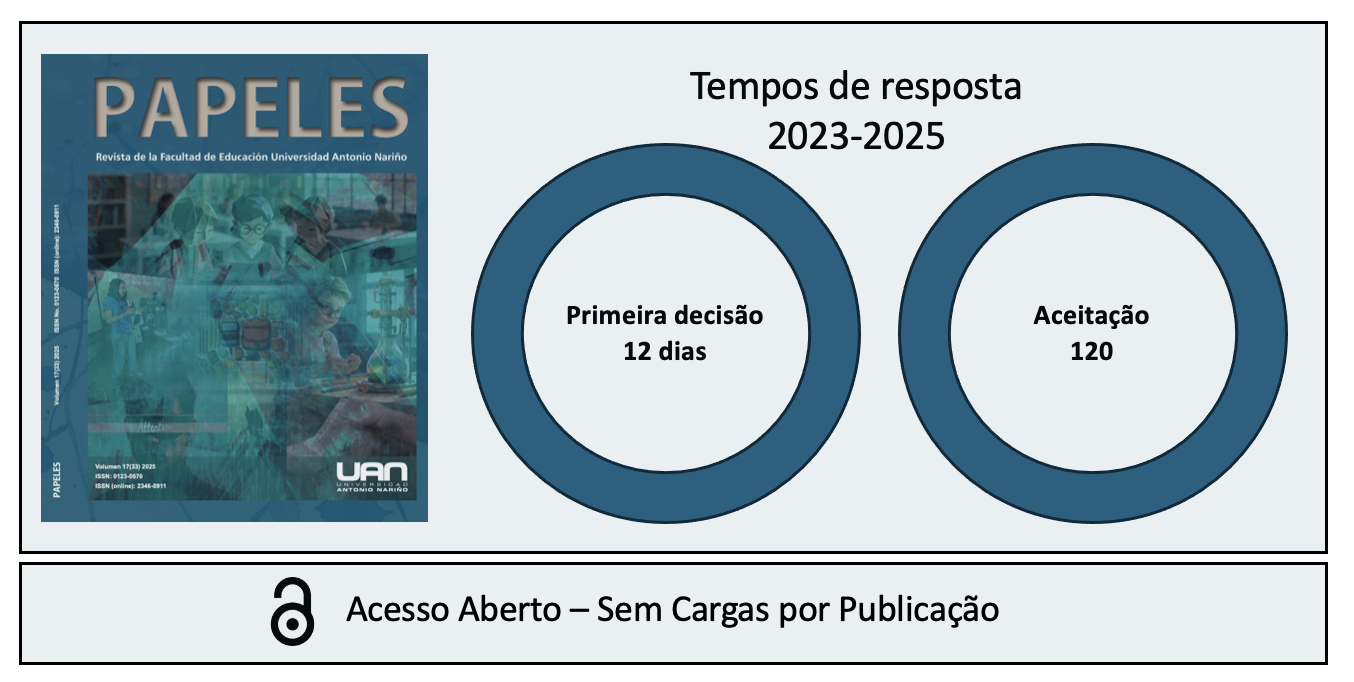Students’ beliefs: Multimodal texts as pedagogical tools in foreign language learning.
Palavras-chave:
creencias de aprendizaje, enseñanza de las lenguas extranjeras, textos multimodalesResumo
This paper presents the results of a research project the objective of which was tocharacterize the beliefs students have when interacting with multimodal texts andwhen they are involved in a foreign language learning process. The study was conductedat the Centro de lenguas of the Universidad Pedagógica Nacional, with advancedlearners of English. The literature review intended to determine the relation between education, postmodern culture, multimodal texts and students’ believes. To collectthe data, surveys, interviews and field notes were used. Findings suggest that for thestudents, multimodal texts are meaningful and motivational pedagogical tools. It wasalso found that students believe that this type of text improves their communicativeskills and helps them think critically.
Downloads
Referências
Adorno, T. (1997), La industria cultural. In A. Silva & J. Barbero (Ed.), Proyectar la comunicación, Bogotá, TM Editores, Instituto de Estudios Sobre Culturas y Comunicación.
Augé, M. (1992), Los no lugares espacios del anonimato, una antropología de la sobremodernidad, Barcelona, Gedisa.
Barthes, R. (1980) Mitologias. México, Siglo XXI editores.
Beyer, B. (1995). Critical thinking. Bloomingtong: Phi Delta Kappa Education Fundation.
Bogdan, R, y Biklen, S. (2006), Qualitative research in education: An introduction to theory and methods, London, Allyn y Bacon.
Brown, H.D. (1994). Principles of learning language and teaching. New Jersey: Prentice Hall Regents.
Derrida, J. (1978), Writing and difference, Chicago, University of Chicago Press.
Fairclough, N. (1992). Critical language awareness. London: Harlow
Ferreira, A. (2006), Researching beliefs about SLA: a critical review, London, Allyn y Bacon
Ferreira, T. (Ed.), Beliefs about SLA, New research approaches, New York: Springer.
Ferrés, J. (2000), Educar en una cultura del espectáculo, Barcelona: Paidós.
Frederic, J. (1991), El posmodernismo o la lógica cultural del capitalismo avanzado, Barcelona, Ediciones Paidós.
Freeman, D. (1998), Doing teacher research, from inquiry to understanding, Canadá, Heinle & Heinle.
Horwitz, E. (1988). The beliefs about language learning of beginning university foreign language students. The modern language journal, Vol 72, 283-294.
------------- (1999). Cultural and situational influences on foreign language learners ´beliefs about language learning. A review of BALLI studies. System, Vol 27, 557-576.
Hymes, D. (1984). Vers la competence de comunication. Paris : Hatier.
Kress, G. y Van Leeuwen, T. (2000), Semiótica social. En: El discurso como estructura y proceso, Barcelona, Gedisa.
Kress, G. y Van Leeuwen, T. (2006), Reading images, the grammar of visual design, London, Routledge.
Kristeva, J. (1982), Desire in language, New New York, Columbia University Press.
Lipovetsky, G. (1990), La era del vacío: ensayos sobre el individualismo contemporáneo, Barcelona, Editorial Anagrama.
Lyotard, J. (2008), La posmodernidad explicada a los niños, Barcelona, Gedisa.
Maqueo, A. (2004). Lenguaje, aprendizaje y enseñanza. El enfoque comunicativo: de la teoría a la práctica, México, Editorial Limusa.
Nuttall, C. (2005). Teaching reading skills in a foreign language. Oxford: Macmillan books for teachers.
Pérez, J. (2002), El ansia de identidad juvenil y la educación. Del narcisismo mediático contemporáneo y las estrategias educativas. Viviendo a toda. Jóvenes, territorios culturales y nuevas sensibilidades. Bogotá: Siglo del hombre editores & Fundación Universidad Central.
Ramírez, L. (2004). Discurso y lenguaje en la educación y la pedagogía, Bogotá, Magisterio.
Richards, J. (2001), Approaches and methods in language teaching, New York, Cambridge University Press.
Richards, J. & Lockhart, C. (1995), Reflective teaching in L2 classrooms. Cambridge, Cambridge University press.
Rodríguez, R. (2006), Métodos y técnicas de trabajo social. España, Universidad de las Palmas.
Sarlo, B. (2004), Escenas de la vida posmoderna. Intelectuales, arte y videocultura en la Argentina, Buenos Aires: Ariel.
Seliger, H. & Shohamy, E. (2003). Second language research methods. Oxford: Osford University Press.
Spender, D. (1980), Man made language, London, Routledge & Kegan Paul.
Wenden, A. L. (1998). Metacognitive knowledge and language learning. Applied linguistics, 19, 515-537.
Van Dijk, T. (1998). Principles of critical discourse analysis. Discourse and society, 4, (2), 249-283.
Downloads
Publicado
-
Resumo277
-
PDF (Español)164
Como Citar
Edição
Seção
Licença

Este trabalho está licenciado sob uma licença Creative Commons Attribution-NonCommercial-ShareAlike 4.0 International License.





